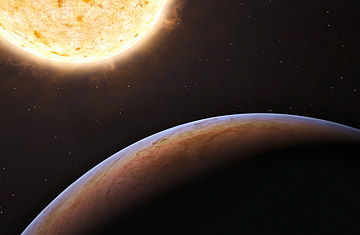
An artist's impression of HIP 13044 b, an exoplanet orbiting a star that entered our galaxy, the Milky Way, from another galaxy
Billions of years before the sun was born, the Milky Way galaxy flicked out its gravitational tongue and slurped down a tiny neighboring galaxy that had ventured too close. The evidence for that ancient act of cosmic cannibalism is the still-digesting remains of the meal: a handful of relatively nearby stars known as the Helmi Stream, whose weird orbits — above and below the plane of the galaxy — are a tip-off to their weird origin.
Now one of those stars has a second claim to fame. HIP 13044, as it's unglamorously known, has a planet whirling around it — the first planet ever found from outside the Milky Way. Aside from its extragalactic origin, the planet itself, found with a medium-size telescope at the European Southern Observatory in Chile and described in a new paper in Science, isn't especially remarkable. It's a bit bigger than Jupiter and orbits its parent star in about 16 days — a "year" so short it would once have been considered impossible for so giant a planet, until multiple discoveries of many similar worlds proved such a revolution rate to be pretty common.
It's the star itself that makes the discovery of a planet surprising, for a couple of reasons. For one thing, its age — perhaps 7 billion to 8 billion years — means that while HIP 13044 was once much like the sun, it's gone through a dramatic change of life. As it burned through its supply of hydrogen, the star would have swelled to become a so-called red giant, tens or even hundreds of times its original size. When that happens to our sun billions of years from now, Earth will probably be destroyed. Indeed, there's some circumstantial evidence that HIP 13044 may have gulped down a few planets itself, says the paper's lead author, Johny Setiawan of Germany's Max Planck Institute for Astronomy in Heidelberg. "The star is a fast rotator," he says, "and theory predicts that if a star swallows a planet, its rotation rate should increase."
But the new planet, called HIP 13044 b, survived the cataclysm. That's probably because the Jupiter-size world originally occupied a Jupiter-like orbit, much farther from its star than Earth is from the sun. It spiraled into its present orbit only after HIP 13044 shrank back to a more dignified size — another common stage of life for stars, which return to their original dimensions when they start burning the helium in their core. A tiny handful of planets have been seen orbiting stars that are currently red giants, but this is the first to be found in the next chapter of a star's life.
The other thing that makes the star unusual is its composition. The sun is mostly hydrogen and helium, but it also has significant traces of heavier elements like oxygen, carbon and iron, a quality astronomers call "metallicity" despite the nonmetallic nature of some of those elements.
"In the Milky Way," says Setiawan, "the more metals a star has, the more likely it is to have planets." The reason for that is simple: both stars and planets coalesce out of the same vast pool of dust and gas. The higher the metallicity, the bigger the supply of building material and the likelier that some will be left over to form planets.
Dwarf galaxies like the one in which HIP 13044 was born, however — and like the two dozen or so that still orbit the Milky Way — have stars that are notably metal-poor. It was unclear until now whether that meant they'd also be planet-poor. The fact that Setiawan and his colleague Rainer Klement, also of the Max Planck Institute, found one so easily suggests this isn't the case. "Either they were incredibly lucky," says Eric Ford, a planet searcher at the University of Florida, "or planets aren't uncommon around stars like these."
Whatever the answer, HIP 13044 b is clearly a very different world from any we've seen before, one that — without the aid of celestial metals — formed in a very different way. And that in turn suggests that the field of planetary science, which seemed so tidy and settled as recently as the 1990s, is still full of surprises.
